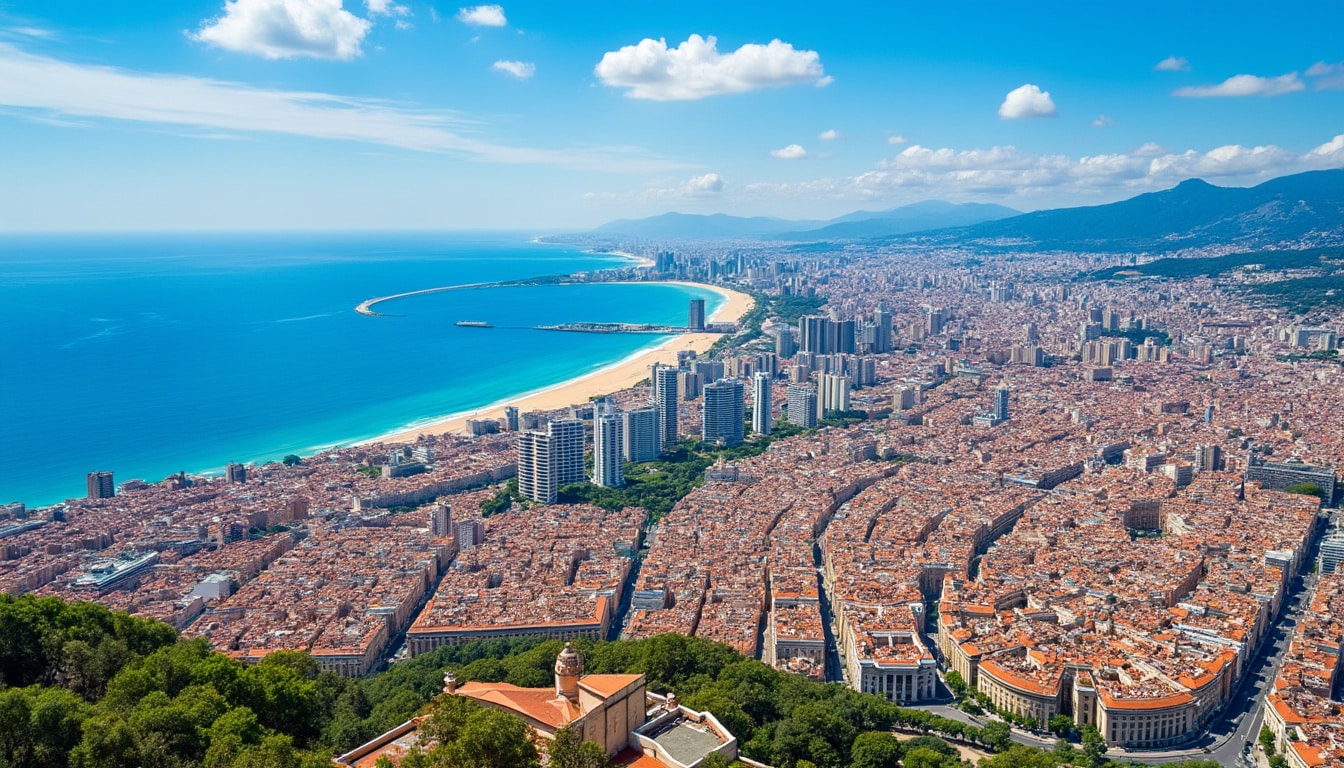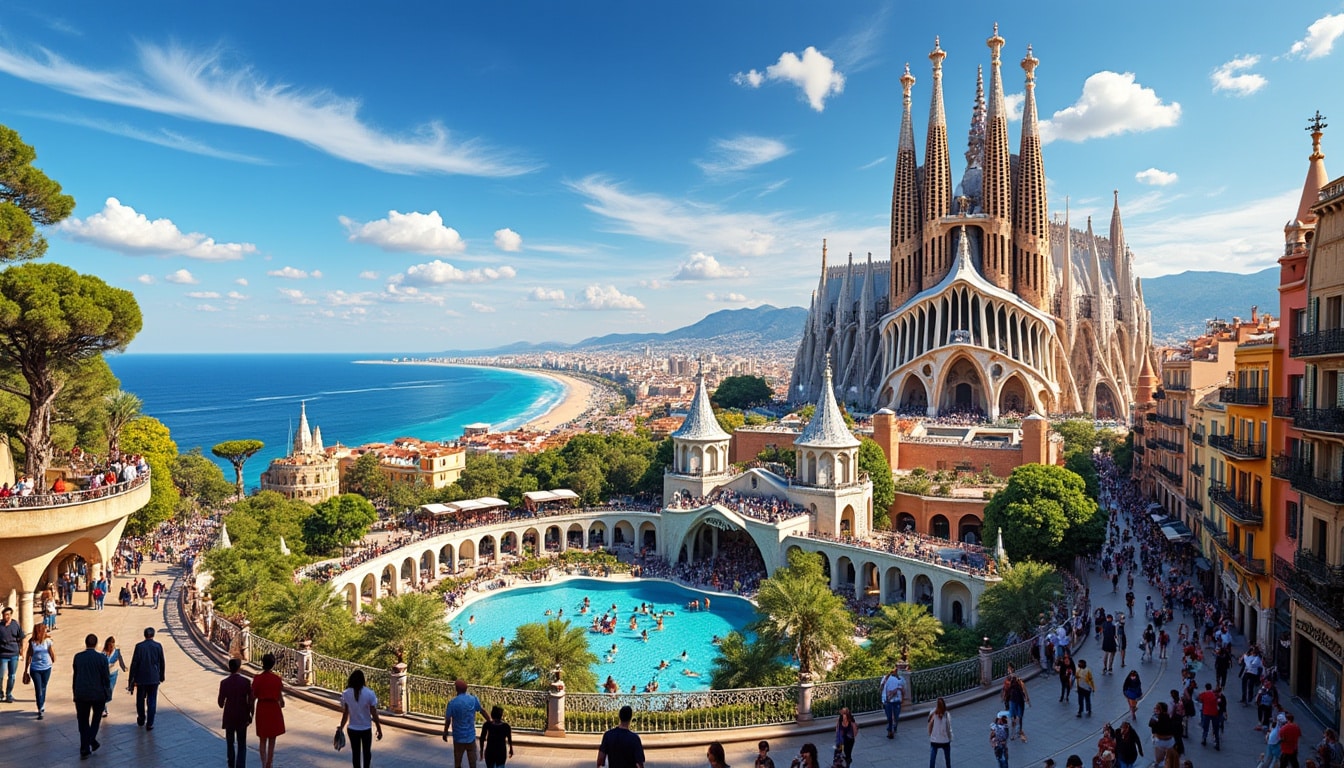Barcelona, a city brimming with culture, history, and breathtaking architecture, is one of Spain’s most vibrant urban centers. The core of its charm lies not only in its vibrant street life and stunning landmarks but also in its strategic positioning. As travelers and residents navigate the city, understanding Barcelona’s location and coordinates is more than just a geographical interest—it’s a key part of exploring its rich heritage and modern allure. The bustling cityscape, with GPS coordinates at approximately 41.38879000° N latitude and 2.15899000° E longitude, positions Barcelona perfectly within Europe, making it a hub of artistic inspiration and economic vitality. As we delve deeper, this city’s geographical location reveals why it’s a quintessential destination for globetrotters and a beloved home for locals.
Exploring Barcelona’s Geographic Coordinates
Barcelona’s geographic coordinates, set at 41.38879000° N latitude and 2.15899000° E longitude, mark it as a city ensconced along the northeastern coast of the Iberian Peninsula. Situated in the autonomous community of Catalonia, Barcelona is Spain’s second-largest city and serves as a pivotal economic and cultural center. This geographic position allows Barcelona to enjoy a Mediterranean climate, characterized by hot summers and mild, wet winters, which is a significant draw for tourists.
The precision of these coordinates, which can also be expressed in degrees, minutes, and seconds as 41° 23′ 19.644” N and 2° 9′ 32.364” E, facilitates navigation and mapping. These details are particularly significant for GPS devices, travel agencies, and anyone needing precise location data. For travelers, understanding these coordinates enhances one’s ability to navigate the vibrant city efficiently, especially with Barcelona GPS Services available that make exploring easier and more efficient.
For those venturing into the city’s intricate urban fabric, knowing these coordinates can spell the difference between wandering aimlessly and precisely locating iconic sites like the Sagrada Familia or Park Güell. Both residents and visitors can benefit from various navigation tools that utilize these coordinates to optimize travel and discover hidden gems within the city’s complex grid.
- 🌍 Barcelona’s Latitude: 41.38879000
- 📍 Longitude: 2.15899000° E
- 🌐 Geographical Area: Catalonia, Spain
- 💼 Economic Center: Second largest in Spain
- 📅 Climate: Mediterranean

The Practicalities of Using Barcelona’s Coordinates
Beyond mere curiosity, the usage of Barcelona’s geographic coordinates serves a variety of practical purposes. For instance, they are essential when utilizing GPS for local transport solutions, like navigating through the city’s expansive public transit system, including trains, buses, and the metro. Moreover, these coordinates are crucial for logistics and real estate planning, where pinpoint accuracy determines optimal locations for business development.
| Function | Use of Coordinates | Impact |
|---|---|---|
| Tourism | Enhanced navigation to landmarks | Increased visitor convenience |
| Real Estate | Site selection | Strategic development planning |
| Transport | Public transport accessibility | Efficiency in commuting |
| Scientific Research | Environmental study location | Accurate data collection |
Why Barcelona’s Location Matters
Barcelona’s position in southern Europe is a linchpin in its success as a thriving cultural and economic hub. Nestled along the Mediterranean coast, its location has historically been a crossroads of trade and cultural exchange. Over the centuries, this has imbued the city with a rich tapestry of influences, from Roman remnants to modernist marvels.
Geographically, being located at this juncture has numerous advantages. For instance, Barcelona’s proximity to other major European cities is a big draw. As part of the Schengen Zone, it allows seamless travel across much of Europe, enhancing its appeal as a regional transport hub. The Barcelona Airport, with its comprehensive flight connections, acts as a critical gateway to both the European continent and the rest of the world.
- ✈️ Close to Major European Hubs
- 🛫 Excellent International Connectivity through Barcelona Airport
- 🗺️ Hub for Cultural Exchange and Economic Growth
- 🏛️ Architectural Landmarks Influenced by Diverse Cultures
This geographical setup not only supports tourism but also propels Barcelona’s real estate market. The city is a desirable location for international investors, further fuelled by its scenic landscapes, architectural charms, and a vibrant lifestyle. As a result, Barcelona real estate continues to be a bustling industry, attracting both domestic and international buyers seeking to invest in one of Europe’s most dynamic cities.
The Influence of Barcelona’s Unique Geographical Layout
The physical layout of Barcelona, enriched with historical sites like the Eixample district, which was designed with a distinctive grid pattern by urban planner Ildefons Cerdà, makes navigation fascinating. This district exemplifies how urban planning and geographic knowledge shape a city. The design strategically incorporates broad streets and chamfered corners, facilitating traffic flow and maximizing sunlight exposure.
Such insights into Barcelona’s urban planning are invaluable for tourists utilizing a comprehensive Barcelona City Guide, equipped with maps highlighting these unique urban features. These guides are vital to exploring the intricate latticework of the city, ensuring travelers make the most of their experience.
Beyond the architecture, Barcelona’s proximity to natural elements significantly enhances the geographic location’s appeal. From the rolling hills of Montjuïc to the sandy expanses of Barceloneta Beach, the city’s topography offers a blend of urban marvel and natural serenity, inviting exploration and adventure.
This unique geographic layout has not only fostered a robust tourism industry but also makes it feasible for Barcelona to host numerous international events and festivals year-round. These events, seamlessly integrated into the city’s geographic setting, enhance its global reputation as a city where history and modernity meld beautifully.
Using Maps and Navigation to Explore Barcelona
To aid exploration, modern technology affords travelers a plethora of tools for navigating Barcelona’s streets. A well-outfitted Barcelona Travel Agency will offer digital maps that highlight key points of interest using detailed GPS coordinates, allowing tourists to dive into the city’s multifaceted attractions with ease and confidence.
Various applications and services, centered around geolocation, cater to a visitor’s every need, from identifying optimal public transport routes to locating Barcelona’s best hotels. Moreover, Barcelona Maps provide detailed insights into the city’s vibrant districts, helping visitors plan their itineraries to encapsulate all must-see destinations efficiently.
- 📱 Digital Maps and Apps for Seamless Navigation
- 🏨 Locating Top Hotels with Ease
- 🚆 Public Transport Integration
- 🗺️ Comprehensive City Guides Available
Technology-enhanced navigation ensures that discovering Barcelona’s artistic wonders and culinary delights remains an enjoyable adventure, helping maintain the city’s status as a top-tier travel destination well into 2025.
The Global Importance of Barcelona’s Strategic Position
Barcelona’s strategic importance is not confined to its immediate surroundings. The city is a pivotal location in global maritime and air routes, further reinforcing its relevance on the world stage. Its ports facilitate extensive commercial and passenger traffic, underscoring Barcelona’s role as a maritime giant.
On an international scale, Barcelona’s prominence is supported by its advanced infrastructure that caters to global commerce and tourism alike. The multitude of services ranging from Barcelona Transport networks to diverse dining experiences ensures that the city maintains its position as a favorite among international tourists and business travelers.
| Feature | Global Significance |
|---|---|
| Port of Barcelona | Key maritime route player |
| Transportation Networks | Efficient Global Connectivity |
| Cultural Festivals | Global Cultural Influence |
In this interplay of geography, culture, and economy, Barcelona not only captivates those who visit but also stands as a beacon of cultural integration and international cooperation. The city’s strategic importance is a testament to its enduring appeal and vitality in the global narrative of leading metropolitan areas.
Barcelona’s Role in Europe’s Future
As Europe continues to evolve its identity in a rapidly changing world, Barcelona’s location and influence will be pivotal in shaping the future of the continent. With its blend of cultural richness, historical depth, and progressive urban development, Barcelona exemplifies a city that balances tradition with modernity.
Efforts to preserve its historical essence while pushing forward in technology and sustainability highlight Barcelona as a model for other European cities aiming to carve out their niche in the global framework. By leveraging its strengths in strategic positioning and geographical magnificence, Barcelona sets the course for an impactful legacy that resonates far beyond its geographic borders.
Frequently Asked Questions (FAQ)
- 🗺️ What are the exact GPS coordinates of Barcelona?
The coordinates are 41.38879000° N latitude and 2.15899000° E longitude. - 🌍 Why is Barcelona’s location significant?
It’s a cultural and economic hub in southern Europe, with excellent connectivity via the Barcelona Airport ensuring global accessibility. - 📈 How does Barcelona’s location affect its real estate?
Its strategic spot and vibrant lifestyle make it highly desirable for international investors and home buyers.
In conclusion, Barcelona’s geographical coordinates do more than just pin the city on a map. They tell the story of a dynamic metropolis, open to the world and ready for the challenges and opportunities of the 21st century.

